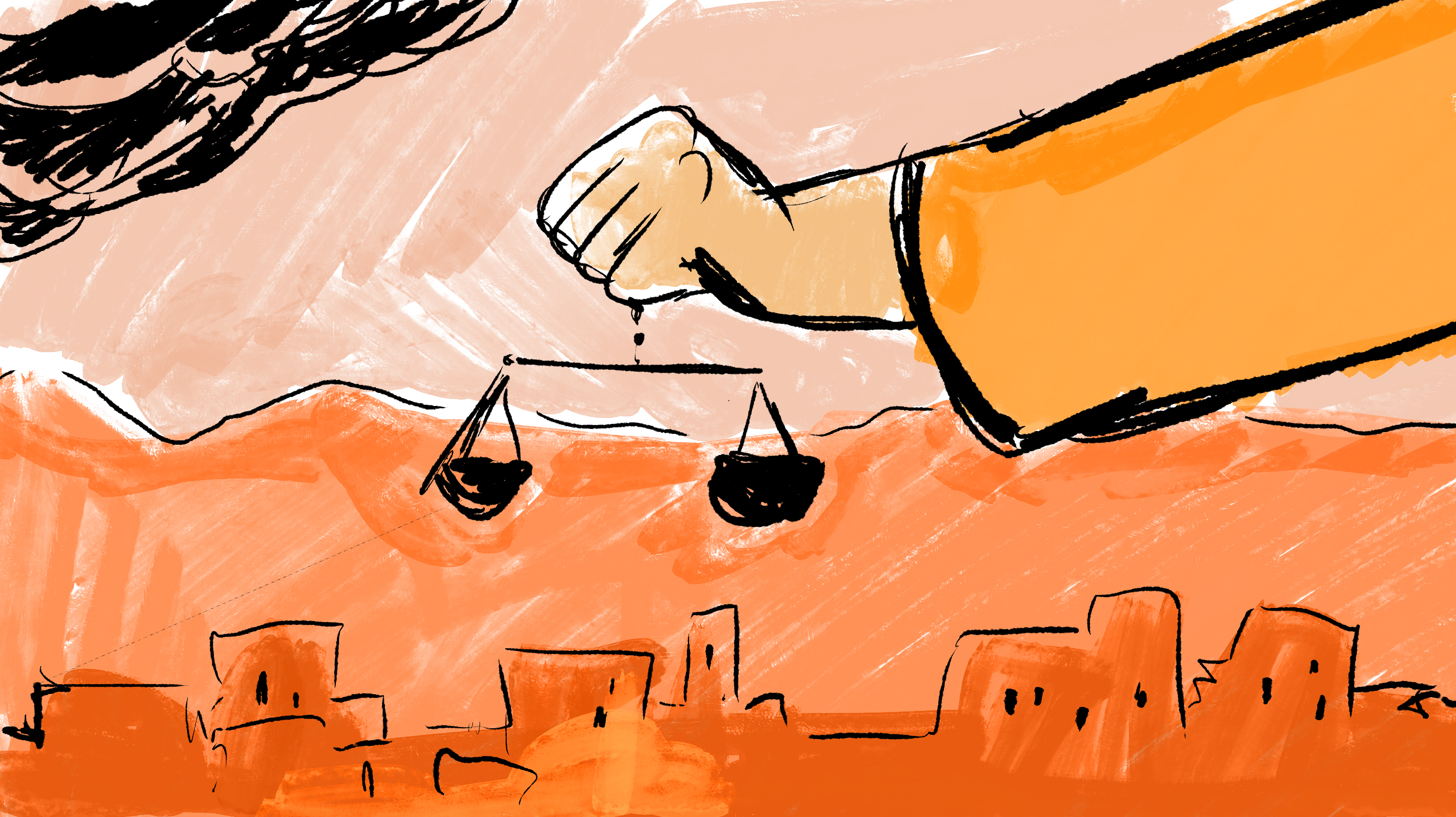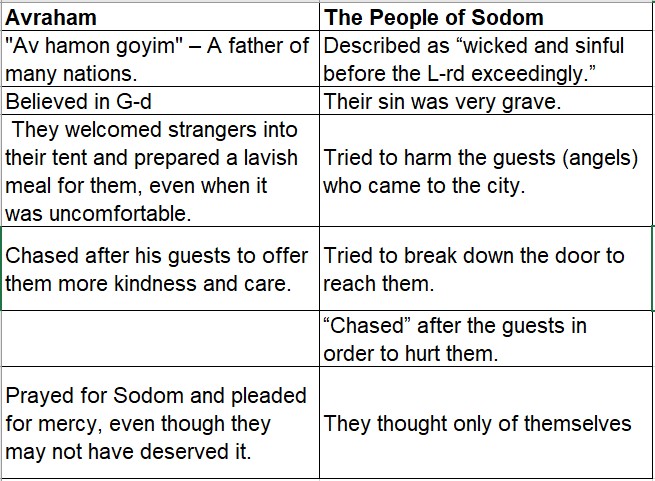

-%D7%9C%D7%91%D7%9F.png)


-%D7%9C%D7%91%D7%9F.png)


-%D7%9C%D7%91%D7%9F.png)

Avraham Avinu stood up for justice and attempted to save the city of Sodom. He did not accept G-d’s decree to destroy Sodom. He felt it would be unjust for the entire city to be destroyed if there were righteous people who would perish along with the wicked. This appeal to G-d serves as an example of Avraham fulfilling his divine mission: “to do righteousness and justice.” We too, throughout the generations, have sought to live out this responsibility.
Unit summary and key values: In this lesson, we will explore Avraham’s dialogue with G-d in response to the decree to destroy Sodom. We will begin with verses in which G-d decides to share His plan with Avraham and explains why Avraham was chosen (“so that he may instruct his children... to do righteousness and justice” – Bereishit 18:19). We will discuss what made Avraham unique—his willingness to seek justice, even when doing so involved personal risk. We will study Avraham’s argument with G-d about saving Sodom and what it teaches us: From Avraham’s side: his desire for justice, his compassion, and his courage to argue with G-d. From G-d’s side: His willingness to listen to Avraham’s repeated requests. We’ll examine how tzedakah u’mishpat have been practiced in Jewish history, and what it means for us as Avraham’s descendants. Finally, we will study the destruction of Sodom and Lot’s rescue. We will consider the core misdeeds that led to Sodom’s destruction. Suggestion for the Teacher: When discussing the sins of Sodom, it may be appropriate—if handled with great care—to introduce the issue of sexual abuse. This is a sensitive but important topic that must be addressed with professionalism and age-appropriate discretion, in consultation with school staff. Discussing such matters in the context of Torah learning reinforces for students that their teachers are a safe address for important issues, and that Torah is relevant to all areas of life. The key values emphasized in this unit include: The moral responsibility that Avraham—and his descendants—have toward others. The importance of acting for justice and not standing idly by in the face of injustice.
El éxodo de Egipto. Mapa con explicacionesSocial Awareness:
Empathy development. When Avraham fought to save Sodom, he demonstrated empathy and a desire to save others—even though they were wicked and very different from his worldview.
In previous lessons, we raised the question: “Why was Avraham chosen to be the father of the nation?”
The verses in this lesson offer an answer.
G-d deliberately includes Avraham in His plan to destroy Sodom and states Avraham’s mission:
“…so that he may instruct his children and his household after him to keep the way of the L-rd by doing righteousness and justice…” (Bereishit 18:19)
Avraham and his descendants are tasked with following the way of G-d through tzedakah u’mishpat.
Indeed, in the story of Sodom, we see this in action. Avraham senses an injustice—the idea of punishing the righteous along with the wicked, without due process.
He addresses G-d with strong language: “Will You sweep away the righteous along with the guilty?” (Breishit 18:23); “Shall not the Judge of all the earth deal justly?” (v. 25)
Avraham boldly pleads with G-d to save the city for the sake of 50, then 45, 40, 30, 20, and finally 10 righteous individuals.
We emphasize that, despite the bold and even confrontational nature of Avraham’s appeal, G-d responds without criticism and even agrees to each request.
Avraham’s repeated pleas come from deep concern and responsibility for others (as “the father of many nations”).
In the end, it becomes clear that not even ten righteous people can be found in Sodom. From this we learn:
After Avraham’s conversation with G-d, Chapter 19 describes the carrying out of the decree and Lot’s rescue.
Note: This unit does not include the story of Avraham’s journey to Gerar and the taking of Sarah by Avimelech (Chapter 20), but teachers may choose to include it. The story appears in Bereishit Chapter 20.

After Sarah receives the announcement of Yitzhak’s birth, the angels proceed toward Sodom to fulfill their mission. Avraham escorts them.
The following verses give us a “glimpse” into the divine perspective, revealing G-d’s thoughts and Avraham’s eternal mission.
Teacher Instructions: Read and explain the following three verses (project them on the board):
(17) The L-rd said, “Shall I hide from Avraham what I am about to do?
(18) since Avraham is to become a great and populous nation and all the nations of the earth are to bless themselves by him.
(19) For I have singled him out, that he may instruct his children and his posterity to keep the way of the L-rd by doing righteousness and justice, in order that the L-rd may bring about for Avraham what He has promised him.”
A page with the verses that can be projected on a screen appears here.
[Brief explanation for the teacher, based on Rabbi Steinsaltz’ commentary: Should I hide from Avraham what I’m about to do? Avraham is beloved to Me, a central figure, and all will claim connection to him. Since he was promised the land of Canaan, he deserves to know what G-d plans to do there.]
Class Discussion:
Question: Remember we asked why Avraham was chosen to be the father of the nation? Do these verses offer an answer? If so, what is it?
Answer: Avraham will instruct his children to follow G-d’s way by practicing tzedakah u’mishpat. This is Avraham’s path and likely why G-d chose him.
What does it mean to perform righteousness and justice…”?
Tzedakah u’mishpat - Means acting with truth, honesty, and integrity, and preventing moral corruption.
The teacher continues relating the story:
Now something dramatic happens:
G-d shares that the outcry from Sodom is great, and their sin is very serious. He plans to “go down” to see if the reality matches the cry (כַּצַּעֲקָתָהּ), and if so, to destroy the city.
Have students respond to a quick Mentimeter survey, or have them respond on this page.
The survey examines how involved the students feel when others are in trouble.
We will dramatize the verses using volunteer readers who will play the parts of Avraham and G-d.
Students in the audience will raise their hands to stop the reading when they notice something significant in how Avraham’s request is presented.
For example:
If students do not stop the reading or struggle to identify these moments, the teacher may guide the discussion (the places that students are expected to note are highlighted in the text).
You may also assign a student to write the decreasing numbers (50, 45, 40, 30, 20, 10) on the board as Avraham’s pleas progress.
At the end, the teacher can write in large letters: “There were not even ten righteous people in Sodom!”
[You can find a page with these verses here that can be used to project the text or distribute to students.]
Students answer: What did I learn from these verses about Avraham’s response?
(Reflect on his character, his choices, and the role G-d gave him as we learned at the beginning of this lesson.)
We’ll conclude by briefly reviewing the execution of the decree to destroy Sodom as described in chapter 19.
Students will view a Genially presentation summarizing the destruction of Sodom.
After reading the story summary, students and teacher may explore related questions, such as:
Option 1:
Compare and contrast the behavior of Avraham and Sarah (at the beginning of the chapter) with that of the people of Sodom. Ask students to list differences, and record them in a table.

Option 2: Studying the Destruction of Sodom Using a Map
Use a map to show students where Sodom was and how the area looked in biblical times—"entirely well-watered"—compared to its dry, desolate state after the destruction.
(Refer to the worksheet: Map of Sodom after its destruction.)
After learning about the destruction of Sodom, we return to the idea that Avraham’s mission was “to do righteousness and justice” (la’asot tzedakah u’mishpat) and will discuss how this value has been carried forward in Jewish history until today.
We will discuss with our students which Jewish figures they know of who saw injustice and could not remain silent to help others - or other people - even if it meant taking personal risks?
Possible examples to discuss:
Ongoing Assignment:
While studying the stories about Avraham, create a visual class project (bulletin board, poster, or digital presentation) that builds a collective picture of Avraham’s character.
After each lesson, students will answer:
“What did I learn about Avraham in this lesson?”
(Possible answers may reflect: values, ways of thinking, character traits, relationships, leadership, etc.)
Teacher Summary:
In this lesson, we explored how Avraham stood up to G-d to argue for justice in Sodom.
We read the verses, discussed the values of justice, acted out the dialogue between Avraham and G-d, and examined the eventual punishment of Sodom.
The central value of tzedakah u’mishpat—righteousness and justice—emerged as a defining feature of Avraham’s life and his legacy to the Jewish people throughout history.